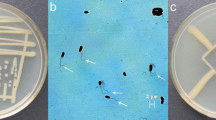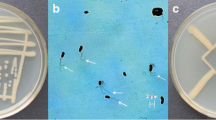Abstract
Pseudomonas lurida strain M2RH3 (MTCC 9245) is a Gram negative, non spore forming, fluorescent bacterium isolated from a high altitude rhizospheric soil from the Uttarakhand Himalayas. The identity of the bacterium was arrived by sequencing of the 16S rRNA gene and subsequent phylogenetic analysis. It grew and exhibited plant growth promoting traits at 4, 15 and 30°C, under in vitro conditions. The expression of plant growth promoting (PGP) traits by the bacterium was highest at 30°C, with a proportionate reduction in PGP activity at lower temperatures. Determination of phosphate solubilization by the bacterium at three incubation temperatures revealed a steady increase in the soluble P levels across the incubation temperatures, coupled with a concomitant drop in the pH levels of the culture supernatant, till the 14th day of incubation. Seed bacterization with the isolate positively influenced the growth and nutrient uptake parameters of wheat seedlings cv. VL 804 in pot culture conditions at controlled cold growing temperature. This is an early report on the phosphate solubilization and plant growth promotion by Pseudomonas lurida, which is a relatively new species of the genus Pseudomonas and opens up a hitherto unknown facet of this bacterium.




Similar content being viewed by others
References
Altschul SF, Gish W, Miller W, Myers EW, Lipman DJ (1990) Basic local alignment search tool. J Mol Biol 215:403–410
Arcand MM, Schneider KD (2006) Plant and microbial based mechanisms to improve the agronomic effectiveness of phosphate rock: a review. Ann Braz Acad Sci 78:791–807
Atlas RM (1995) The handbook of microbiological media for the examination of food. CRC Press, Boca Raton, p 197
Bakker AW, Schipper B (1987) Microbial cyanide production in the rhizosphere in relation to potato yield reduction and Pseudomonas spp. mediated plant growth stimulation. Soil Biol Biochem 19:451–457
Behrendt U, Ulrich A, Schumann P, Meyer JM, Spröer C (2007) Pseudomonas lurida sp. nov., a fluorescent species associated with the phyllosphere of grasses. Int J Syst Evol Microbiol 57:979–985
Collins CH, Lyne PM (1980) Microbiological methods. Butterworth and Co. (Publishers) Ltd, London
Deubel A, Gransee A, Merbach W (2000) Transformation of organic rhizodepositions by rhizosphere bacteria and its influence on the availability of tertiary calcium phosphate. J Plant Nutr Soil Sci 163:387–392
Di Simine CD, Sayer JA, Gadd GM (1998) Solubilization of zinc phosphate by a strain of Pseudomonas fluorescens isolated from a forest soil. Biol Fertil Soils 28:87–94
Elliot LF, Lynch JM (1984) Pseudomonas as a factor in the growth of winter wheat (Triticum aestivum L.). Soil Biol Biochem 16:69–71
Gaind S, Gaur AC (1991) Thermotolerent phosphate solubilizing microorganisms and their interaction with mung-bean. Plant Soil 133:141–149
Goldstein AH (1995) Recent progress in understanding the molecular genetics and biochemistry of calcium phosphate solubilization by Gram negative bacteria. Biol Agric Hortic 12:185–193
Gordon AS, Weber RP (1951) Colorimetric estimation of indole acetic acid. Plant Physiol 26:192–195
Gulati A, Rahi P, Vyas P (2007) Characterization of phosphate-solubilizing fluorescent Pseudomonads from the rhizosphere of seabuckthorn growing in the cold deserts of Himalayas. Curr Microbiol 56:73–79
Hwangbo H, Park RD, Kim YW, Rim YS, Park KH, Kim TH, Suh JS, Kim KY (2003) 2-ketogluconic acid production and phosphate solubilization by Enterobacter intermedium. Curr Microbiol 47:87–92
Jackson ML (1973) Soil chemical analysis. Prentice Hall of India Pvt Ltd, New Delhi, pp 25–214
Jones DL, Darrah PR (1994) Role of root derived organic acids in the mobilization of nutrients from the rhizosphere. Plant Soil 166:247–257
Kaksonen AH, Plumb JJ, Robertson WJ, Spring S, Schumann P, Franzmann PD, Puhakka JA (2006) Novel thermophilic sulfate-reducing bacteria from a geothermally active underground mine in Japan. Appl Environ Microbiol 72:3759–3762
Kassen R, Rainey PB (2004) The ecology and genetics of microbial diversity. Ann Rev Microbiol 58:207–231
Katiyar V, Goel R (2003) Solubilization of inorganic phosphate and plant growth promotion by cold tolerant mutants of Pseudomonas fluorescens. Microbiol Res 158:163–168
Khalid A, Arshad M, Zahir ZA (2004) Screening plant growth promoting rhizobacteria for improving growth and yield of wheat. J Appl Microbiol 96:473–480
Kim KY, Hwangbo H, Kim YW, Kim HJ, Park KH, Kim YC, Seoung KY (2002) Organic acid production and phosphate solubilization by Enterobacter intermedium 60-2G. Korean J Soil Sci Fert 35:59–67
Kimura M (1980) A simple method for estimating evolutionary rate of base substitutions through comparative studies of nucleotide sequences. J Mol Evol 16:111–120
Mehta S, Nautiyal CS (2001) An efficient method for qualitative screening of phosphate-solubilizing bacteria. Curr Microbiol 43:51–56
Mishra PK, Mishra S, Selvakumar G, Bisht SC, Kundu S, Bisht JK, Gupta HS (2008) Characterization of a psychrotrophic plant growth promoting Pseudomonas PGERs 17 (MTCC 9000) isolated from North Western Indian Himalayas. Ann Microbiol 58(4):1–8
Mishra PK, Mishra S, Bisht SC, Selvakumar G, Kundu S, Bisht JK, Gupta HS (2009) Isolation, molecular characterization and plant growth promotion of a cold tolerant bacterium Pseudomonas sp. NARs 9 (NTCC 9002) from the Indian Himalayas. Biological Res 42:305–312
Murphy JP, Riley JP (1962) A modified single solution method for the determination of the phosphate in natural waters. Anal Chem Acta 27:31–36
Musarrat J, Bano N, Rao RAK (2000) Isolation and characterization of 2, 4-dichlorophenoxyacetic acid-catabolyzing bacteria and their biodegradation efficiency in soil. World J Microbiol Biotechnol 16:495–497
Olsen SR, Sommers LE (1982) Phosphorus. In: Page AL, Miller RH, Keeney DR (eds) Methods of soil analysis, part2. Chemical and microbiological properties. American Society of Agronomy, Madison, pp 403–430
Pal SS (1998) Interaction of an acid tolerant strain of phosphate solubilizing bacteria with a few acid tolerant crops. Plant Soil 198:169–177
Pandey A, Palni LMS (1998) Isolation of Pseudomonas corrugata from Sikkim Himalayas. World J Microbiol Biotechnol 14:411–413
Pandey A, Trivedi P, Palni LMS (2006) Characterization of phosphate solubilizing and antagonistic strain of Pseudomonas putida (BO) isolated from a sub-alpine location in the Indian central Himalaya. Curr Microbiol 53:102–107
Peix A, Rivas R, Mateos PF, Martinez-Molina E, Rodrigue-Barrueco C, Velazquez E (2003) Pseudomonas rhizosphaerae sp. nov., a novel species that actively solubilizes phosphate in vitro. Int J Syst Evol Microbiol 53:2067–2072
Peix A, Rivas R, Santa-Regina I, Mateos PF, Martinez-Molina E, Rodrigue-Barrueco C, Velazquez E (2004) Pseudomonas lutea sp. nov., a novel phosphate-solubilizing bacterium isolated from the rhizosphere of grasses. Int J Syst Evol Microbiol 54:847–850
Rodríguez H, Fraga R (1999) Phosphate solubilizing bacteria and their role in plant growth promotion. Biotech Adv 17:319–339
Saitou N, Nei M (1987) The neighbor-joining method: a new method for reconstructing phylogenetic trees. Mol Biol Evol 4:406–425
Schwyn B, Neilands JB (1987) Universal chemical assay for the detection and determination of siderophore. Anal Biochem 160:47–56
Seeley HW, Vandermark PJ, Lee JJ (1990) Microbes in action. A laboratory manual of microbiology, IV edn. W.H. Freeman & Co, New York, p 351
Selvakumar G, Kundu S, Joshi P, Nazim S, Gupta AD, Mishra PK, Gupta HS (2008a) Characterization of a cold-tolerant plant growth-promoting bacterium Pantoea dispersa 1A isolated from a sub-alpine soil in the North Western Indian Himalayas. World J Microbiol Biotechnol 24:955–960
Selvakumar G, Mohan M, Kundu S, Gupta AD, Joshi P, Nazim S, Gupta HS (2008b) Cold tolerance and plant growth promotion potential of Serratia marcescens strain SRM (MTCC 8708) isolated from flowers of summer squash (Cucurbita pepo). Lett Appl Microbiol 46:171–175
Selvakumar G, Joshi P, Mishra PK, Bisht JK, Gupta HS (2009a) Mountain aspect influences the genetic glustering of psychrotolerant phosphate solubilizing Pseudomonads in the Uttarakhand Himalayas. Curr Microbiol 59:432–438
Selvakumar G, Joshi P, Nazim S, Mishra PK, Kundu S, Gupta HS (2009b) Exiguobacterium acetylicum strain 1P (MTCC 8707) a novel bacterial antagonist from the North Western Indian Himalayas. World J Microbiol Biotechnol 24:955–960
Selvakumar G, Joshi P, Nazim S, Mishra PK, Bisht JK, Gupta HS (2009c) Phosphate solubilization and growth promotion by Pseudomonas fragi CS11RH1 (MTCC 8984) a psychrotolerant bacterium isolated from a high altitude Himalayan rhizosphere. Biologia 64(2):239–245
Tamura K, Dudley J, Nei M, Kumar S (2007) MEGA 4: molecular evolutionary genetics analysis (MEGA) software version 4.0. Mol Biol Evol 24(8):1596–1599
Thompson JD, Gibson TJ, Plewniak F, Jeanmougin F, Higgins DG (1997) The Clustal X windows interface: flexible strategies for multiple sequence alignment aided by quality analysis tools. Nucleic Acids Res 24:4876–4882
Trivedi P, Sa T (2007) Pseudomonas corrugata (NRRL B-30409) mutants increased phosphate solubilization, organic acid production, and plant growth at low temperatures. Curr Microbiol 56:140–144
Vazquez P, Holguin G, Puente ME, Lopez-Cortez A, Bashan Y (2000) Phosphate-solubilizing microorganisms associated with the rhizosphere of mangroves in a semiarid costal lagoon. Biol Fertil Soil 30:460–468
Vyas P, Gulati A (2009) Organic acid production in vitro and plant growth promotion in maize under controlled environment by phosphate-solubilizing fluorescent Pseudomonas. BMC Microbiol 9:174–188
Acknowledgments
This study was supported by the ICAR network project “Application of Microorganisms in Agriculture and Allied Sectors”. Sanjay Kumar is acknowledged for his technical assistance in analyzing the plant nutrients.
Author information
Authors and Affiliations
Corresponding author
Rights and permissions
About this article
Cite this article
Selvakumar, G., Joshi, P., Suyal, P. et al. Pseudomonas lurida M2RH3 (MTCC 9245), a psychrotolerant bacterium from the Uttarakhand Himalayas, solubilizes phosphate and promotes wheat seedling growth. World J Microbiol Biotechnol 27, 1129–1135 (2011). https://doi.org/10.1007/s11274-010-0559-4
Received:
Accepted:
Published:
Issue Date:
DOI: https://doi.org/10.1007/s11274-010-0559-4




